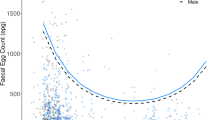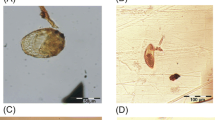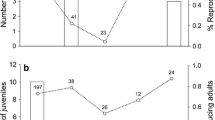Abstract
Abundance and prevalence of helminth infections often differ between host sexes, and are usually biased in favor of males. Relatively few cases of female-biased parasitism have been reported. We sampled bank voles in three woodland sites in N.E. Poland over 11 years at 3–4-year intervals, and assessed their parasite burdens. Prevalence and abundance of the stomach nematode Mastophorus muris were consistently higher among females. Among adult female bank voles from the two sites that showed the highest prevalence with M. muris, both prevalence and abundance were significantly higher in lactating bank voles, but not pregnant animals, and the effect of lactation was evident in both sites, in all four surveys, and in both age classes. Although the magnitude of the effect of lactation varied between years, it was not confounded by any significant interactions with other factors. We hypothesize that mature and reproductively active female bank voles are subject to higher exposure compared with males of similar age, as a consequence of the increased content of invertebrates in their diet, including the intermediate hosts of M. muris, required to meet the higher increased energy and protein demands of nursing litters throughout the summer months.

Similar content being viewed by others
References
Abu-Madi MA, Behnke JM, Prabhaker KS, Al-Ibrahim R, Lewis JW (2010) Intestinal helminths of feral cat populations from urban and suburban districts of Qatar. Vet Parasitol 168:284–292
Bajer A, Bednarska M, Pawełczyk A, Behnke JM, Gilbert FS, Siński E (2002) Prevalence and abundance of Cryptosporidium parvum and Giardia spp. in wild rural rodents from the Mazury Lake District region of Poland. Parasitology 125:21–34
Baker DG (1998) Natural pathogens of laboratory mice, rats, and rabbits and their effects on research. Clin Microbiol Rev 11:231–266
Barnard CJ, Behnke JM (2001) From psychoneuroimmunology to ecological immunology: life history strategies and immunity trade-offs. In: Ader R, Felten DL, Cohen N (eds) Psychoneuroimmunology, Vol. 2, 3rd edn. Academic, San Diego, pp 35–47
Barnard CJ, Behnke JM, Bajer A, Bray D, Race T, Frake K, Osmond J, Dinmore J, Siński E (2002) Local variation in endoparasite intensities of bank voles (Clethrionomys glareolus) from ecologically similar sites: morphometric and endocrine correlates. J Helminthol 76:103–113
Beagley KW, Gockel CM (2003) Regulation of innate and adaptive immunity by the female sex hormones oestradiol and progesterone. FEMS Immunol Med Mic 38:13–22
Beaucournu JC, Chabaud AG (1963) Infestation spontanée de Puces par le spiruride Mastophorus muris (Gmelin). Ann Parasitol Hum Comp 38:931–934
Behnke J, Wakelin D (1973) The survival of Trichuris muris in wild populations of its natural hosts. Parasitology 67:157–164
Behnke JM, Barnard CJ, Bajer A, Bray D, Dinmore J, Frake K, Osmond J, Race T, Siński E (2001) Variation in the helminth community structure in bank voles (Clethrionomys glareolus) from three comparable localities in the Mazury Lake District region of Poland. Parasitology 123:401–414
Behnke JM, Bajer A, Harris PD, Newington L, Pidgeon E, Rowlands G, Sheriff C, Kuliś-Malkowska K, Siński E, Gilbert FS, Barnard CJ (2008a) Temporal and between-site variation in helminth communities of bank voles (Myodes glareolus) from N.E. Poland. 1. Regional fauna and component community levels. Parasitology 135:985–997
Behnke JM, Bajer A, Harris PD, Newington L, Pidgeon E, Rowlands G, Sheriff C, Kuliś-Malkowska K, Siński E, Gilbert FS, Barnard CJ (2008b) Temporal and between-site variation in helminth communities of bank voles (Myodes glareolus) from N.E. Poland. 2. The infracommunity level. Parasitology 135:999–1018
Beldade P, Mateus AR, Keller RA (2011) Evolution and molecular mechanisms of adaptive developmental plasticity. Mol Ecol 20:1347–1363
Bendinelli M, Pistello M, Lombardi S, Poli A, Garzelli C, Matteucci D, Ceccherini-Nelli L, Malvaldi G, Tozzini F (1995) Feline immunodeficiency virus: an interesting model for AIDS studies and an important cat pathogen. Clin Microbiol Rev 8:87–112
Boinski S (1988) Sex-differences in the foraging behavior of squirrel monkeys in a seasonal habitat. Behav Ecol Sociobiol 23:177–186
Bordes F, Ponlet N, Gouy de Bellocq J, Ribas A, Krasnov B, Morand S (2012) Is there sex-biased resistance and tolerance in Mediterranean wood mouse (Apodemus sylvaticus) populations facing multiple helminth infections? Oecologia 170:123–135
Bush AO, Lafferty KD, Lotz JM, Shostak AW (1997) Parasitology meets ecology on its own terms: Margolis et al. revisited. J Parasitol 83:575–583
Christe P, Arlettaz R, Vogel P (2000) Variation in intensity of a parasitic mite (Spinturnix myoti) in relation to the reproductive cycle and immunocompetence of its bat host (Myotis myotis). Ecol Lett 3:207–212
Christe P, Glaizot O, Evanno G, Bruyndonckx N, Devevey G, Yannic G, Patthey P, Maeder A, Vogel P, Arlettaz R (2007) Host sex and ectoparasites choice: preference for, and higher survival on female hosts. J Anim Ecol 76:703–710
Connan RM (1970) The effect of host lactation on the self cure of Nippostrongylus brasiliensis in rats. Parasitology 61:27–33
Dhangadamajhi G, Kar SK, Ranjit MR (2009) High prevalence and gender bias in distribution of Plasmodium malariae infection in central east-coast India. Trop Biomed 26:326–333
Dineen JK, Kelly JD (1972) The suppression of rejection of Nippostrongylus brasiliensis in lactating rats: the nature of the immunological defect. Immunology 22:1–12
Dobson FS (1982) Competition for mates and predominant juvenile male dispersal in mammals. Anim Behav 30:1183–1192
Drobney RD, Train CT, Fredrickson LH (1983) Dynamics of the platyhelminth fauna of wood duck in relation to food habitats and reproductive state. J Parasitol 69:375–380
Duneau D, Ebert D (2012) Host sexual dimorphism and parasite adaptation. PLoS Biol 10(2):e1001271. doi:10.1371/journal.pbio.1001271
Eccard JA, Ylonen H (2006) Adaptive food choice of bank voles in a novel environment: choices enhance reproductive status in winter and spring. Ann Zool Fenn 43:2–8
Elliott JM (1977) Some methods for the statistical analysis of samples of benthic invertebrates. Freshwater Biological Association, Cumbria
Ferrari N, Cattadori IM, Nespereira J, Rizzoli A, Hudson PJ (2004) The role of host sex in parasite dynamics: field experiments on the yellow-necked mouse Apodemus flavicollis. Ecol Lett 7:88–94
Ferrari N, Rosa R, Pugliese A, Hudson PJ (2007) The role of sex in parasite dynamics: model simulations on transmission of Heligmosomoides polygyrus in populations of yellow necked mice, Apodemus flavicollis. Int J Parasitol 37:341–349
Fredensborg BL, Poulin R (2006) Parasitism shaping host life-history evolution: adaptive responses in a marine gastropod to infection by trematodes. J Anim Ecol 75:44–53
Gębczyńska Z (1976) Food habitats of bank vole and phonological phases of plants in an oak hornbeam forest. Acta Theriol 16:223–236
Gorrell JC, Schulte-Hosteddea AI (2008) Patterns of parasitism and body size in red squirrels (Tamiasciurus hudsonicus). Can J Zool 86:99–110
Grossman CJ (1985) Interactions between the gonadal steroids and the immune system. Science 227:257–261
Hamilton WD, Zuk M (1982) Heritable true fitness and bright birds: a role for parasites? Science 218:384–387
Harrison A, Scantlebury M, Montgomery WI (2010) Body mass and sex—biased parasitism in wood mice Apodemus sylvaticus. Oikos 119:1099–1104
Hawlena H, Abramsky Z, Krasnov B (2005) Age-biased parasitism and density dependent distribution of fleas (Siphonaptera) on a desert rodent. Oecologia 146:200–208
Hillegass MA, Waterman JM, Roth JD (2008) The influence of sex and sociality on parasite loads in an African ground squirrel. Behav Ecol 19:1006–1011
Horne T, Ylonen H (1998) Heritabilities of dominance-related traits in male bank voles (Clethrionomys glareolus). Evolution 52:894–899
Huerta L, Terrazas LI, Sciutto E, Larralde C (1992) Immunological mediation of gonadal effects on experimental murine cysticercosis caused by Taenia crassiceps metacestodes. J Parasitol 78:471–476
Hurst RJM, Else KJ (2013) Trichuris muris research revisited: a journey through time. Parasitology 140:1325–1339
Hurst JL, Smith J (1995) Mus spretus Lataste: a hygienic house mouse? Anim Behav 49:827–834
Johnson MS, Thomson SC, Speakman JR (2001a) Limits to sustained energy intake I.Lactation in the laboratory mouse Mus musculus. J Exp Biol 204:1925–1935
Johnson MS, Thomson SC, Speakman JR (2001b) Limits to sustained energy intake III. Effects of concurrent pregnancy and lactation in Mus musculus. J Exp Biol 204:1947–1956
Kaczmarski F (1966) Bioenergetics of pregnancy and lactation in the bank vole. Acta Theriol 19:409–417
Khokhlova IS, Spinu M, Krasnov BR, Degen AA (2004) Immune response to fleas in a wild desert rodent: effect of parasite species, parasite burden, sex of host and host parasitological experience. J Exp Biol 207:2725–2733
Kiffner C, Stanko M, Morand S, Khokhlova IS, Shenbrot GI, Laudisoit A, Leirs H, Hawlena H, Krasnov BR (2013) Sex-biased parasitism is not universal: evidence from rodent-flea associations from three biomes. Oecologia 173:1009–1022
Kiffner C, Stanko M, Morand S, Khokhlova IS, Shenbrot GI, Laudisoit A, Leirs H, Hawlena H, Krasnov BR (2014) Variable effects of host characteristics on species richness of flea infracommunities in rodents from three continents. Parasitol Res 113:2777–2877
Klein SL (2000) The effects of hormones on sex differences in infection: from genes to behavior. Neurosci Biobehav R 24:627–638
Korpimaki E, Tolonen P, Bennett GF (1995) Blood parasites, sexual selection and reproductive success of European kestrels. Ecoscience 2:335–343
Koskela E, Mappes T, Ylonen H (1997) Territorial behaviour and reproductive success of bank vole Clethrionomys glareolus females. J Anim Ecol 66:341–349
Krasmanovic L (1979) Ishrana vrste Clethrionomys glareolus (Microtinae, Rodentia). Zbor Prirod Nauke Matice Srpske (Novi Sad) 56:96–108
Krasnov BR (2012) Functional and evolutionary ecology of fleas - a model for ecological parasitology. Cambridge University Press, Cambridge
Krasnov BR, Morand S, Hawlena H, Khokhlova I, Shenbrot GI (2005) Sex-biased parasitism, seasonality and sexual size dimorphism in desert rodents. Oecologia 146:209–217
Krasnov BR, Stanko M, Matthee S, Laudisoit A, Leirs H, Khokhlova IS, Korallo-Vinarskaya NP, Vinarski MV, Morand S (2011) Male hosts drive infracommunity structure of ectoparasites. Oecologia 166:1099–1110
Krebs CJ (1996) Ecology. The experimental analysis of distribution and abundance. Polish edition. Wydawnictwo Naukowe PWN Sp. z.o.o., Warszawa, Poland
Lane JE, Boutin S, Gunn MR, Coltman DW (2009) Sexually selected behaviour: red squirrel males search for reproductive success. J Anim Ecol 78:296–304
Lewis JW (1987) Helminth parasites of British rodents and insectivores. Mammal Rev 17:81–93
Litvinova EA, Goncharova EP, Zaydman AM, Zenkova MA, Moshkin MP (2010) Female scent signals enhance the resistance of male mice to influenza. PLoS ONE 5:e9473. doi:10.1371/ journal.pone.0009473
Lively CM (1989) Adaptation by a parasitic trematode to local-populations of its snail host. Evolution 43:1663–1671
Lowrie FM, Behnke JM, Barnard CJ (2004) Density-dependent effects on the survival and growth of the rodent stomach worm Protospirura muricola in laboratory mice. J Helminthol 78:121–128
Mappes T, Ylonen H (1997) Reproductive effort of female bank voles in a risky environment. Evol Ecol 11:591–598
Marchlewska-Koj A, Kruczek M, Olejniczak P (2003) Mating behaviour of bank voles (Clethrionomys glareolus) modified by hormonal and social factors. Mamm Biol 68:144–152
Margolis L, Esch GW, Holmes JC, Kuris AM, Schad GA (1982) The use of ecological terms in parasitology (report of an ad hoc committee of The American Society of Parasitologists). J Parasitol 68:131–133
McAdam AG, Millar JS (1999) Dietary protein constraint in age at maturity: an experimental test with wild deer mice. J Anim Ecol 68:733–740
McCurdy DG, Shutler D, Mullie A, Forbes MR (1998) Sex-biased parasitism of avian hosts: relations to blood parasite taxon and mating system. Oikos 82:303–312
Miyata J (1939) Studies on the life history of the nematode Protospirura muris (Gmelin) parasitic in the stomach of the rat, especially on the relation of the intermediate hosts, cockroaches, skin moth and rat fleas. Vol Jub Sadao Yoshida 1:101–136 (In Japanese)
Moore SL, Wilson K (2002) Parasites as a viability cost of sexual selection in natural populations of mammals. Science 297:2015–2018
Mooring MS, Patton ML, Reisig DD, Osborne ER, Kanallakan AL, Aubery SM (2006) Sexually dimorphic grooming in bison: the influence of body size, activity budget and androgens. Anim Behav 72:737–745
Morales-Montor J, Baig S, Hallal-Calleros C, Damian RT (2002) Taenia crassiceps: androgen reconstitution of the host leads to protection during cysticercosis. Exp Parasitol 100:209–216
Morales-Montor J, Chavarria A, De León MA, Del Castillo LI, Escobedo EG, Sánchez EN, Vargas JA, Hernández-Flores M, Romo-González T, Larralde C (2004) Host gender in parasitic infections of mammals: an evolution of the female host supremacy paradigm. J Parasitol 90:531–546
Morris P (1972) A review of mammalian age determination methods. Mammal Rev 2:69–104
Ohlberger J, Langangen O, Edeline E, Olsen EM, Winfield IJ, Fletcher JM, James JB, Stenseth NC, Vollestad LA (2011) Pathogen-induced rapid evolution in a vertebrate life-history trait. Proc R Soc B 278:35–41
Ostfeld RS (1985) Limiting resources and territoriality in microtine rodents. Am Nat 126:1–15
Owens IPF (2002) Sex differences in mortality rate. Science 297:2008–2009
Patterson JEH, Ruckstuhl KE (2013) Parasite infection and host group size: a meta analytical review. Parasitology 140:803–813
Perkins SE, Cattadori IM, Tagliapietra V, Rizzoli AP, Hudson PJ (2003) Empirical evidence for key hosts in persistence of a tick-borne disease. Int J Parasitol 33:909–917
Perkins SE, Ferrari MF, Hudson PJ (2008) The effects of social structure and sex biased transmission on macroparasite infection. Parasitology 135:1561–1569
Post DM, Armbrust TS, Horne EA, Goheen JR (2001) Sexual segregation results in differences in content and quality of bison (Bos bison) diets. J Mammal 82:407–413
Poulin R (1993) The disparity between observed and uniform distributions: a new look at parasite aggregation. Int J Parasitol 23:937–944
Poulin R (1996) Sexual inequalities in helminth infections: a cost of being a male? Am Nat 147:287–295
Poulin R (2006) Evolutionary ecology of parasites, 2nd edn. Princeton University Press, Princeton
Quentin JC (1970) Morphogenese larvarie du spiruride Mastophorus muris (Gmelin, 1790). Ann Parasitol Hum Comp 45:839–855
Roberts ML, Buchanan KL, Evans MR (2004) Testing the immunocompetence handicap hypothesis: a review of the evidence. Anim Behav 68:227–239
Rohlf FJ, Sokal RR (1995) Statistical tables. W. H. Freeman & Company, San Francisco
Rolff J (2002) Bateman’s principle and immunity. Proc R Soc B 269:867–872
Sanchez A, Devevey G, Bize P (2011) Female-biased infection and transmission of the gastrointestinal nematode Trichuris arvicolae infecting the common vole, Microtus arvalis. Int J Parasitol 41:1397–1402
Schutgens M, Cook B, Gilbert F, Behnke JM (2013) Behavioural changes in the flour beetle Tribolium confusum infected with the spirurid nematode Protospirura muricola. J Helminthol in press
Selby G, Wakelin D (1973) Suppression of the immune response to Trichuris muris in lactating mice. Parasitology 71:77–85
Shine R (1989) Ecological causes for the evolution of sexual dimorphism: a review of the evidence. Q Rev Biol 64:419–461
Shogaki Y, Mizuno S, Itoh H (1972) On Protospirura muris (Gmelin) a parasic nematode of the brown rat in Nagoya City. Jpn J Parasitol 21:28–38
Terrazas LI, Bojalil R, Govenezensky T, Larralde C (1994) A role for 17-beta-estradiol in immunoendocrine regulation of murine cysticercosis (Taenia crassiceps). J Parasitol 80:563–568
Viitala J, Hoffmeyer I (1985) Social organization in Clethrionomys compared with Microtus and Apodemus: social odours, chemistry and biological effects. Ann Zool Fenn 22:359–371
Walsh PT, McCreless E, Pedersena BA (2013) Faecal avoidance and selective foraging: do wild mice have the luxury to avoid faeces? Anim Behav 86:559–566
Waterman JM (1995) The social-organization of the Cape ground squirrel (Xerus inauris, Rodentia, Sciuridae). Ethology 101:130–147
Waterman JM, Macklin GF, Enright C (2014) Sex-biased parasitism in Richardson’s ground squirrels (Urocitellus richardsonii) depends on the parasite examined. Can J Zool 92:73–79
Watts CHS (1968) The foods eaten by wood mice (Apodemus sylvaticus) and bank voles (Clethrionomys glareolus) in Wytham Woods, Berkshire. J Anim Ecol 37:25–41
Williams GC (1966) Adaptation and natural selection. Princeton University Press, Princeton
Wolff JO, Lundy KI, Baccus R (1988) Dispersal, inbreeding avoidance and reproductive success in white-footed mice. Anim Behav 36:456–465
Zuk M (1990) Reproductive strategies and sex differences in disease susceptibility: an evolutionary viewpoint. Parasitol Today 6:231–233
Zuk M, McKean KA (1996) Sex differences in parasite infections: patterns 609 and processes. Int J Parasitol 26:1009–2014
Acknowledgments
We thank the Universities of Nottingham and Warsaw for enabling this study through financial support for travel and consumables. We thank also Mgrs Grzegorz Gorecki and Anna Zaborowska, the wardens of the field station at Urwitałt, for the use of the facilities and to Dr. Dorota Dudek who advised us on some of the relevant bank vole literature. Our work was supported additionally by travel grants to JMB from the Royal Society and from the Grabowski Fund. Finally, we thank all the undergraduate student helpers from both NU and WU who have helped with field work during the four expeditions to our study sites. All authors declare no conflict of interest.
Authorship
The study was conceived and designed by MG and JMB. Samples were collected and lab work was carried out by MG, AB, MA, JBB, and JMB. Statistical analysis was conducted by MG and JMB. The ms was written by JMB and MG in consultation with all co-authors.
Author information
Authors and Affiliations
Corresponding author
Rights and permissions
About this article
Cite this article
Grzybek, M., Bajer, A., Behnke-Borowczyk, J. et al. Female host sex-biased parasitism with the rodent stomach nematode Mastophorus muris in wild bank voles (Myodes glareolus). Parasitol Res 114, 523–533 (2015). https://doi.org/10.1007/s00436-014-4214-0
Received:
Accepted:
Published:
Issue Date:
DOI: https://doi.org/10.1007/s00436-014-4214-0




